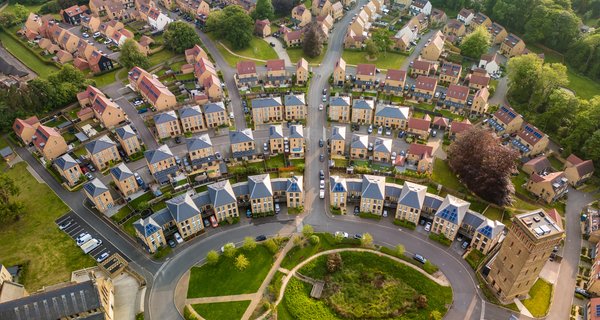How much difference do the different factors make?
We have tested the factors that could make heat pumps relatively cheaper in the future, and it is clear that some have a disproportionate effect while others make only a marginal difference. Figure 13 illustrates how much each factor affects the difference between annual costs for a heat pump and a gas boiler. For consistency, these effects are measured relative to the ‘baseline’ scenario (ie, assuming no significant developments in all other factors), for a 2030 installation, with no government subsidies. The most influential factors are:
- A £5,000 heat pump subsidy
- Wholesale gas price
- Levy rebalancing (based on per-unit costs)
- 0% interest rates on heat pump loans.
In reality, factors are all highly interdependent. For example, changes to the relative prices of gas and electricity have a much stronger effect on price parity if absolute energy prices are higher, because running costs then make up a higher share of lifetime costs.
The varied effects of policies on the relative costs of heat pumps and boilers
Figure 13
This scatter plot illustrates how much various policy interventions and developments reduce the additional annual costs of a heat pump compared to a gas boiler. The cost changes are in reference to the baseline scenario, for an average household installing a heat pump in 2030 (ie., with no subsidy). Nine interventions are displayed, four of which affect upfront costs and five which affect running costs. The largest effects are seen for a £5,000 subsidy (£480), high wholesale gas prices (£450), levies rebalancing (by unit) (£300) and 0% loans (£290). Low wholesale electricity prices and increased SCOP have the smallest effect (<£100). The effect on different home archetypes is displayed separately along the average home. Large differences in impact between archetypes are seen especially in the case of low gas prices and levies rebalancing, with larger older properties benefitting more.
Rebalancing levies has the most significant effect on running costs
The relative electricity price has the largest impact on cost parity, as running costs account for approximately 60% of lifetime costs.
- Equalising levies on the basis of a typical home’s consumption (used in scenarios 1 and 3) reduces the difference in lifetime costs by £70 on average. This ranges from £190 (for a small home) to £260 (for a large home).
- Equalising the per-unit policy costs for both electricity and gas (used in scenario 2) reduces the difference in costs by £300 on average (£140–£560).
Changes in the wholesale prices of gas or electricity will affect the relative running costs of heat pumps and gas boilers. Changes in the gas price could have a significant effect, while changes in the wholesale price of electricity would have a small effect.
- Assuming DESNZ high price trajectory for gas shifts the relative running costs by £450 per year on average (£210–£820).
- Assuming the low price trajectory for electricity shifts the relative running costs by £30 per year on average (£10–£50).
This is because: i) gas prices are more uncertain so DESNZ projections have a much larger range between high and low scenarios; ii) wholesale costs are a slightly bigger share of household gas prices; and iii) more units of gas are used for heating than units of electricity.
Technological improvements in the efficiency of heat pumps add relatively small savings in our scenarios. The optimistic scenario in which average efficiency increases from 3.0 to 3.3 saves households on average £70 (range of £40–140) a year with reference electricity prices. The effect becomes even smaller with cheaper electricity. However, this reflects the relatively modest increases in efficiency we tested. Greater increases, such as raising the SCOP of a typical heat pump to 4.0, would have a larger impact.
Subsidies and loans will influence upfront costs more than general cost reductions
- We considered two options for how the market price of heat pumps might change, both based on our earlier analysis: How to reduce the cost of heat pumps. Our default assumption is that prices will fall by around 2.5% per year.
- If heat pump prices drop by 4.5% each year then the heat pump lifetime costs would fall by a further £130 on average, relative to the baseline scenario (£110–£160).
Government subsidies have a big impact on price parity, reducing the cost for all households by a flat amount. Adding a £5,000 subsidy (used in the ‘High subsidy’ scenario) lowers the annual cost of heat pumps for all households by £480 a year compared to baseline. This saving gets higher if interest rates rise, and lower if interest rates fall; the saving would be £333 per year at 0% interest rates.
The interest rates for heat pump finance also have a significant effect on the relative total costs. Heat pumps purchased either with cash, or with a 0% interest rate loan would be £290 per year cheaper on average (£240–£360) than those bought using the 5% rate loan used in our model. But when we deduct a subsidy (say £5,000), the effect of 0% interest rates is much smaller in absolute terms – £150 on average (£90–£210).
The interest rates on finance for any low-carbon heating measures will affect the total investment requirements of the heat transition. If we assume for simplicity that other types of low-carbon heating (heat networks, networked heat pumps, ground-source heat pumps) will have costs comparable to air-source heat pumps per household and assuming the baseline future price trajectory (2.5% annual drop), the total capital cost of investing in low-carbon heat between 2025 and 2035 could be around £100bn before any interest. Each one percentage point rise in the interest rate increases costs by roughly £9bn (Figure 14).

Total cost of low-carbon heat installations 2025-2035 under different interest rates
Figure 14
This chart depicts how the total cost of low-carbon heat installations from 2025 to 2035 would change under different interest rates. The total capex is based on targets set by the CCC's Sixth Carbon Budget and includes all low-carbon domestic heating excluding direct electric. Starting at £96bn at a 0% interest rate, the cost escalates progressively to £103bn at 1%, £111bn at 2%, continuing to increase through £120bn at 3%, £129bn at 4%, £138bn at 5%, £148bn at 6%, £157bn at 7%, £167bn at 8%, £178bn at 9%, and peaks at £188bn at a 10% interest rate. The trend line is a smooth, upward curve, illustrating the significant impact of rising interest rates on the total cost of installations.
The costs of installation vary between homes of a similar size and age
Throughout the analysis we have relied on a single cost of installation per home archetype. But in reality, heat pump prices vary substantially even within a single archetype. For example, the median installation cost for the most common archetype (semi-detached, terraced houses and maisonettes built post-1950) was £11,870 in 2023, but 20% of households in this archetype paid less than £9,800 while 20% of households paid more than £14,500. This largely reflects differences in what individual homes require to install a heat pump; particularly whether they need wider upgrades to their heating systems (including new radiators, hot water tanks or fabric insulation).
Considering how subtle the differences in costs between gas boilers and heat pumps are in our scenarios, it is important to note that even when the average home saves money on a heat pump, there will likely be a significant portion of homes that are either much better off or slightly worse off due to these variations in installation costs. Figure 15 shows one example of this effect, using our ‘High innovation’ scenario. While the majority of households in 2030 will save money installing a heat pump, those at the upper end of install cost requirements (roughly the top 30% of households in each archetype) may need to pay slightly more than for a gas boiler. Equally, a significant proportion of households will be significantly better off installing a heat pump.

Annualised whole-life costs of heat pumps by deciles compared to gas boiler
Figure 15
This bar chart shows the annualised whole-life costs of heat pumps by deciles, alongside a single bar for the costs of gas boilers. It zooms in on costs for a 2030 installation under the "High innovation" scenario for three selected archetypes: flats, semi-detached/terraced houses/maisonettes, and detached houses, all post-1950. For all archetypes, the three top cost deciles surpass the average cost of gas boilers, particularly noticeable in detached houses. Costs for each decile are divided into install costs and running costs. While the distribution of install costs of heat pumps is shown by deciles, we only use one mean figure for running costs. Although we expect that homes with larger heat pump requirements would also have higher heat demand – which would translate into higher gas boiler running costs –, we do not have accurate data to link installation cost distribution to heat demand distribution.








